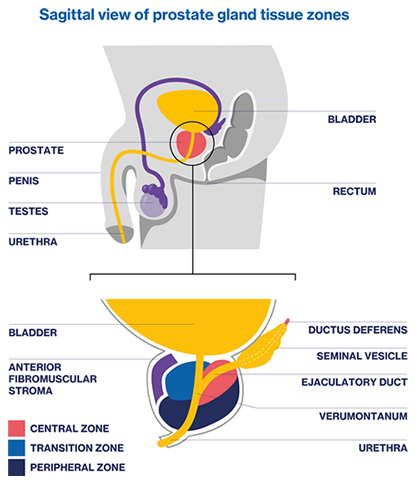Understanding Metastatic Castration-Resistant Prostate Cancer (mCRPC)

What is the prostate?
The prostate is a small, walnut-shaped gland part of the male reproductive system, that sits below the bladder and in front of the rectum.1,12 It surrounds the upper part of the urethra, which carries urine from the bladder and semen from the testes out of the body via the penis.12
The prostate produces seminal fluid, a component of semen, which nourishes and transports sperm, to help propel seminal fluid into the urethra during ejaculation.1,12

Anatomically, the prostate can be divided into 3 different types of tissue zones from which cancer can start:13
- The central zone (CZ) surrounds the ejaculatory ducts from which less than 5% of prostate cancers originate and considered be more aggressive.
- The transition zone (TZ) envelops the urethra as it enters the prostate gland and it is associated with benign prostatic hyperplasia (BPH), which refers to the normal enlargement of the prostate gland that occurs with aging and can lead to urinary problems. Around 20% of prostate cancers start in the transition zone (TZ).
- The peripheral zone (PZ), closer to rectum, where the majority of the prostatic glandular tissue is located. Approximately 70-80% of prostate cancers arise in this zone.
What is localized, locally advanced and metastatic prostate cancer?
Prostate cancer develops when abnormal cells in the prostate start to divide and grow out of control,1 and can be seen progressing from localized to metastatic disease.
In the early stage of the disease, the tumor is only present in the prostate gland. Over time, the tumor may grow or spread, but it remains within the confines of the prostate and does not extend outside the gland or affect any other part of the body. This stage of cancer is known as localized prostate cancer.1,12
As the tumor progresses, it can extend beyond the prostate gland and invade nearby structures such as the seminal vesicles, rectum, bladder, or lymph nodes close to the prostate. At this stage, the cancer is considered locally advanced or locoregional prostate cancer. It signifies that the cancer has spread to surrounding areas but has not yet metastasized to other parts of the body.12
Finally, at the final stage of the disease, called, metastatic or advanced, the cancer spreads beyond the prostate, growing in other organs or tissues, such as the bones, lymph nodes, lung or liver. This make it even more challenging to treat. Metastatic prostate cancer can be either homone sensitive (mHSPC) or castration-resistant (mCRPC), depending on its response to hormone therapy.12

- Center for Disease Control and Prevention (CDC). What is Prostate Cancer? Updated June 17, 2023. Accessed October 31, 2023. https://www.cdc.gov/cancer/prostate/basic_info/what-is-prostate-cancer.htm
- Sung H, Ferlay J, Siegel RL, Sung H, et al. Global cancer statistics 2020: GLOBOCAN estimates of incidence and mortality worldwide for 36 cancers in 185 countries. CA Cancer J Clin. 2021;71(3):209-249. doi:10.3322/caac.21660
- Cancer Research UK. What is prostate cancer? https://www.cancerresearchuk.org/about-cancer/prostate-cancer/about (accessed Feb 2024);
- Sperling. Prostate cancer. https://sperlingprostatecenter.com/prostate-zone-anatomy-prostate-cancer-and-imaging/ (accessed Feb 2024).



